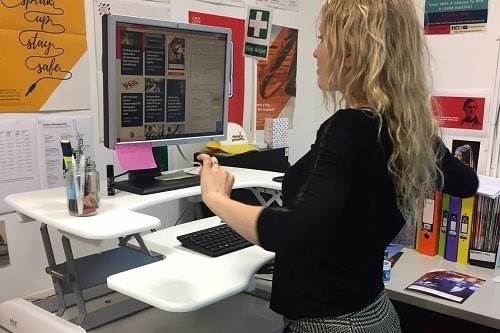Sit-stand desks are a useful way of reducing sedentary behaviour at work, but it’s essential workers are trained to use them properly.
Features
Sit-stand desks: avoid the pitfalls
Both instinctively and through a growing body of research, we know that sitting down for long periods is bad for us.
Prolonged sitting can not only cause discomfort and lead to musculoskeletal problems, but sedentary behaviour has also been linked with an increased risk of type 2 diabetes, cardiovascular disease, some cancers, and mortality, often independently of body mass index and physical activity, as well as with poor mental health, and a lower quality of life.
Yet sitting all day at a desk is exactly what many workers do, both in the office and when working from home – they are among the most sedentary populations, spending 70–85 per cent of their time at work sitting, in large part for prolonged periods of 30 minutes or more.
The sit-stand desk is a widely adopted intervention introduced in a bid to cut sitting time and create healthier workplaces. Used correctly, it can improve wellbeing and productivity, with research indicating that those who decrease their sitting time at work not only had reduced neck and shoulder pain, but also had a significant increase in productivity and energy.
 Guy Osmond: "Sit-stand desks aren’t a magic bullet – but they are a powerful tool."
Guy Osmond: "Sit-stand desks aren’t a magic bullet – but they are a powerful tool."
In many cases, sit-stand desks are underused, as we have found when completing display screen equipment (DSE) assessments. Staff have been given the kit, but due to a lack of training and understanding of their true benefits, the positive benefits of the sit-stand desk are rarely harnessed.
Too many suppliers will deliver sit-stand desks with virtually no information about how to set them up correctly, or how to use them effectively. Our DSE assessors and trainers are going into workplaces and seeing issues ranging from poor posture and incorrect height adjustment to people standing for too long. Without the right support, sit-stand desks can actually end up creating health and safety issues.
Movement is the key
A crucial misconception is that the purpose of a sit-stand desk is to allow people to ‘stand’ to work; standing for long periods can be bad for you too – leading to varicose veins, or foot problems, for example.
It’s not so much about standing – it’s about movement – alternating from sitting to standing is where the benefit is. We recommend about five to six minutes of standing for 30 minutes sitting.
Or people might like to consider the 30-minute cycle described by Professor Alan Hedge of Cornell University – sit for 20 minutes, stand for eight and move and stretch for two minutes. This gives 16 sit-to-stand changes, two hours of standing and 30 minutes of moving for an average workday – all of which can help increase blood flow and reduce all the previous issues mentioned.
Posture and positioning
How you stand at a sit-stand desk also matters, and it is also far too easy to replace a poor sitting posture with a poor standing posture. Many users set the desk too low, and end up slouched forward, leaning on the desk with their head tilted up at the screen creating a very uncomfortable ‘vulture neck’ – something which can cause neck and upper back aches, tension headaches and shoulder pain. Many people also lock their knees which restricts blood flow and puts stress on your spine.
 At stand-up desks, you should be standing upright with your legs apart and slightly bent with one foot marginally in front of the other. Photograph: Osmond Ergonomics
At stand-up desks, you should be standing upright with your legs apart and slightly bent with one foot marginally in front of the other. Photograph: Osmond Ergonomics
To counteract these potentially serious musculoskeletal issues, you should be standing upright with your legs apart and slightly bent with one foot marginally in front of the other, and your elbows should be level with the desk. It may be necessary to raise or tilt the monitor slightly so the visible screen top is just below eye level, in order to avoid tipping your head forward.
Training and education
Done right, moving over to sit-stand desks represents a significant change for workers, and needs to be managed in that way. The first thing is to make sure all staff understand the physical benefits of using a new sit-stand desk and the key process of moving, rather than just standing.
Employers need to provide the education piece to ensure the desks are being set up and used effectively. Through training, installation support, or even online workshops often run by the supplier – you can then relay the information to your staff so they better understand how to use the products to benefit them the most. If you’re unable to get this information from your supplier, then most DSE assessors will have the knowledge on how to correctly use a sit-stand desk.
As a reminder, it’s worth having signs and displays on the desks, around the office, or use an internal social media platform such as Teams or Chatter.
Even when employees are working from home, it’s the employer’s responsibility to make sure their team members are using their equipment properly, and as such home workers also need this education and understanding to use a sit-stand desk correctly, reducing the risk of home worker health issues, as well liability for the employer.
A culture shift
It’s also vital to understand that the transition to sit-stand desks is much more than a change of furniture; it’s actually a culture shift.
So training is not the final step – staff empowerment is key. Employers need to build a culture where people take breaks, and movement is accepted and encouraged in a way that’s right for the organisation’s business model.
 Staff should understand the physical benefits of using a new sit-stand desk and the key process of moving, rather than just standing. Photograph: Britsafe
Staff should understand the physical benefits of using a new sit-stand desk and the key process of moving, rather than just standing. Photograph: Britsafe
In my decades working with businesses, I have seen a range of approaches to encourage movement, from ‘walking meetings’ to limiting the number of printers per floor so people need to move from their desks to pick up their print-outs.
A deliberate approach should be applied to sit-stand desks because if everyone continues to sit, no one will feel able to move their desk up and stand. Invite staff to set reminders to shift positions using free apps, or more sophisticated software that can trigger reminders on computer screens or even the desks themselves. Or you could encourage people to stand for certain tasks and activities – sorting paperwork for example, or whenever a colleague comes over for a quick conversation.
And while there will always be those in any organisation who are reluctant or reject change outright, you can ‘find your champions’ – those who get it straight away can be tasked with sharing that enthusiasm with others.
Sit-stand desks aren’t a magic bullet – but they are a powerful tool. Implemented correctly, they can help trigger a culture shift away from static, sedentary working environments to offices that encourage more movement – that shift can be transformative for health, wellbeing and productivity.
For more information, blogs, advice and free webinars on sit-stand desks and other ergonomic solutions, see: ergonomics.co.uk
Guy Osmond is managing director of Osmond Ergonomics
FEATURES

From crisis to prevention: the urgent role of employers in upstreaming health
By Dr Julie Riggs, British Safety Council on 16 June 2025
Poor public health and long-term sickness absence are placing extreme financial pressure on the UK’s health and social care system and the overall economy. However, by investing in workplace health prevention programmes and education initiatives, employers can help reduce the scale of ill health among the population and minimise the associated costs for society and business alike.

The AI safety revolution: augmentation, not elimination
By Alex Nichol, Notify Technology on 16 June 2025
Artificial Intelligence looks set to vastly reduce the amount of time and effort required to record, create and analyse occupational safety and ESG data, procedures and performance, while automatically providing insight into areas for improvement and areas of excellence.

Protecting lone workers: a structured approach is critical
By Naz Dossa, Peoplesafe on 06 June 2025
Whether dealing with the public in their homes or working in remote locations, lone workers face a variety of risks to their health, safety and wellbeing. It’s therefore vital that employers systematically identify and assess the specific hazards lone workers face and then implement suitable measures to mitigate them.



